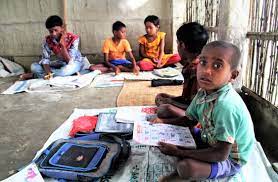Illiteracy & Disparities in Education
Relevant for sociology optional Paper- 2 (Unit- 13 : Social Changes in India)

Illiteracy and disparities in education have been longstanding problems in India. Despite efforts to increase literacy rates, there is still a significant percentage of the population that is unable to read or write. This lack of education has far-reaching consequences for individuals, families, and communities, and it perpetuates a cycle of poverty and disadvantage.
The issue of illiteracy is particularly acute in rural areas, where access to education is limited. Many families in these areas cannot afford to send their children to school, and even when they can, the quality of education is often poor. Teachers in rural areas may be underqualified or overworked, and schools may lack basic resources such as textbooks and classroom materials.
The consequences of illiteracy are profound. Individuals who are unable to read or write may struggle to find employment or participate fully in civic life. They may be more susceptible to exploitation and may lack the skills needed to make informed decisions about their health and well-being. Illiteracy also has intergenerational effects, as parents who cannot read or write may struggle to provide adequate support to their children in their education.
Disparities in education are also a significant issue in India. Despite progress in recent years, there are still significant disparities in access to education based on factors such as gender, caste, and economic status. Girls are particularly disadvantaged, as they are more likely to drop out of school or be prevented from attending in the first place. This is often due to cultural norms that prioritize boys’ education over girls’ education or to the economic pressures that force families to prioritize the education of their sons.
Caste-based disparities also persist, with Dalit and Adivasi children facing significant barriers to accessing education. These children are often relegated to low-quality schools, and they may face discrimination and prejudice from teachers and peers. Economic disparities also play a significant role in access to education, with children from low-income families being less likely to attend school and more likely to drop out.
The consequences of these disparities are significant. Children who are unable to access education are more likely to be trapped in a cycle of poverty and disadvantage. They may be more susceptible to child labor, early marriage, and other forms of exploitation. Disparities in education also perpetuate social inequality, as those who are denied access to education are less likely to be able to challenge the status quo and advocate for their rights.
Efforts to address illiteracy and disparities in education must be multifaceted and comprehensive. This includes increasing access to education, improving the quality of education, and addressing the social and cultural norms that perpetuate inequality. Governments must invest in education and ensure that all children have access to quality schooling, regardless of their gender, caste, or economic status. Teachers must be trained and supported to provide high-quality education, and schools must be equipped with the resources needed to support student learning.
Efforts to address illiteracy and disparities in education must also address the root causes of these issues, including poverty, discrimination, and social inequality. This requires a commitment to addressing these underlying factors through policies that promote economic development, social inclusion, and human rights.
In conclusion, illiteracy and disparities in education are significant challenges in India that have far-reaching consequences for individuals, families, and communities. Addressing these issues requires a comprehensive approach that includes increasing access to education, improving the quality of education, and addressing the underlying factors that perpetuate inequality. By investing in education and promoting social inclusion, India can break the cycle of poverty and disadvantage and create a brighter future for all its citizens.
For more such free UPSC notes, Articles, News & Views Join our Telegram Channel. https://t.me/triumphias
Click the link below to see the details about the UPSC – Civils courses offered by Triumph IAS. https://triumphias.com/pages-all-courses.php


